Water / Soil / Ground Environment
Conservation of the Water Environment - Chapter 3
3. Conservation of the Water Environment
1. Water Pollution / Present Status and Countermeasures
(1) Establishment of Environmental Quality Standards
Under the Basic Environment Law, Environmental Quality Standards (EQS) for water pollutants are water quality target levels to be achieved and maintained in public waters. These standards are established to achieve two major goals: protection of human health and conservation of the living environment. To achieve the first goal, uniform national standards applicable to all public waters are established. To achieve the second goal, rivers, lakes, reservoirs, and coastal waters are classified based on water usage, and EQS values are established for each class. These values are then to be applied to each public water body.
In March 1993, the Environment Agency broadened and strengthened the EQS for protecting human health. As a result. EQS for a total of twenty-three substances are now stipulated. These EQS were established with due consideration of potential health hazards associated with the intake of these substances through drinking water and/or fish and shellfish. In addition, twenty-five other items were also selected for precautionary monitoring in water environments.
Presently, EQS for the human health have identified twenty-three substances, such as cadmium and total cyanogen, with due consideration to potential health hazards associated with uptake of these substances through drinking water and/or fish and shellfish. And EQS for groundwater pollution was also established in March 1997. In addition, twenty-five other items were also determined for monitoring and guideline value.
EQS for the living environment have established values for biochemical oxygen demand (BOD), chemical oxygen demand (COD), dissolved oxygen (DO), and other variables. To prevent eutrophication, EQS for nitrogen and phosphorus were established for lakes and reservoirs. Provisional guideline values have also been set for sediments contaminated by mercury and polychlorinated biphenyl compounds (PCBs). Removal of the sediments is required if the guideline values are exceeded.
Environmental Quality Standards for Water Pollutants
Standards related to the protection of human health.
| Items | Standard Values |
|---|---|
| Cadmium | 0.01 mg/liter or less |
| Total cyanide | Not detectable |
| Lead | 0.01 mg/liter or less |
| Chromium (VI) | 0.05 mg/liter or less |
| Arsenic | 0.01 mg/liter or less |
| Total mercury | 0.0005 mg/liter or less |
| Alkyl mercury | Not detectable |
| PCBs | Not detectable |
| Dichloromethane | 0.02 mg/liter or less |
| Carbon tetrachloride | 0.002 mg/liter or less |
| 1, 2-Dichloroethane | 0.004 mg/liter or less |
| 1, 1-Dichloroethylene | 0.02 mg/liter or less |
| cis-1,2-Dichloroethylene | 0.04 mg/liter or less |
| 1, l, l-Trichloroethane | 1.0 mg/liter or less |
| 1,1,2-Trichloroethane | 0.006 mg/liter or less |
| Trichloroethylene | 0.03 mg/liter or less |
| Tetrachloroethylene | 0.01 mg/liter or less |
| l, 3-Dichloropropene | 0.002 mg/liter or less |
| Thiram | 0.006 mg/liter or less |
| Simazine | 0.003 mg/liter or less |
| Thiobencarb | 0.02 mg/liter or less |
| Benzene | 0.01 mg/liter or less |
| Selenium | 0.01 mg/liter or less |
| Nitrate-N and nitrite-N | 10 mg/liter or less |
| Fluoride | 0.8 mg/liter or less |
| Boron | 0.2 mg/liter or less |
- Notes:
- These are yearly average values. But the standard values for total cyanide are based on maximum values.
Items for monitoring
These items are detected in the water environment , and they should be monitored continuously.
| Items | Guideline Values |
|---|---|
| Chloroform | 0.06 mg/liter or less |
| trans-1,2-Dichloroethylene | 0.04 mg/liter or less |
| l, 2-Dichloropropane | 0.06 mg/liter or less |
| p-Dichlorobenzene | 0.3 mg/liter or less |
| Isoxathion | 0.008 mg/liter or less |
| Diazinon | 0.005 mg/liter or less |
| Fenitrothion | 0.003 mg/liter or less |
| Isoprothiolane | 0.04 mg/liter or less |
| Oxine-copper | 0.04 mg/liter or less |
| Chlorothalonil | 0.05 mg/liter or less |
| Propyzamide | 0.008 mg/liter or less |
| EPN | 0.006 mg/liter or less |
| Dichlorvos | 0.008 mg/liter or less |
| Fenobcarb | 0.03 mg/liter or less |
| IBP | 0.008 mg/liter or less |
| CNP | - |
| Toluene | 0.6 mg/liter or less |
| Xylene | 0.4 mg/liter or less |
| 2-Ethylhexyl phthalate | 0.06 mg/liter or less |
| Nickel | - |
| Molybdenum | 0.07 mg/liter or less |
| Antimony | - |
Standards Related to the Conservation of the Living Environment
(a) Rivers
| Class | Item | Standard value | ||||
|---|---|---|---|---|---|---|
| Water use | pH | BOD | SS | DO | Total coliform | |
| AA | Water supply class 1, conservation of natural environment and uses listed in A-E |
6.5-8.5 | 1 mg/l or less | 25 mg/l or less | 7.5 mg/l or more | 50 MPN/100ml or less |
| A | Water supply class 2, fishery class 1, bathing and uses listed in B-E |
6.5-8.5 | 2 mg/l or less | 25 mg/l or less | 7.5 mg/l or more | 1000 MPN/100ml or less |
| B | Water supply class 3, fisheryclass 2, and uses listed in C-E |
6.5-8.5 | 3 mg/l or less | 25 mg/l or less | 5 mg/l or more |
5000 MPN/100ml or less |
| C | Fishery class 3, industrial water class 1, and uses listed in D-E |
6.5-8.5 | 5 mg/l or less | 50 mg/l or less | 5 mg/l or more |
- |
| D | Industrial water class 2, agricultural water and uses listed in E |
6.0-8.5 | 8 mg/l or less | 100 mg/l or less | 2 mg/l or more |
- |
| E | Industrial water class 3 and conservation of environment |
6.0-8.5 | 10 mg/l or less | Floating Matter such as garbage should not be observed | 2 mg/l or more |
- |
(BOD: Biochemical Oxygen Demand, SS: Suspended Solids, DO: Dissolved Oxygen)
- Notes:
- 1. The standard value is based on the daily average value. The same applies to the standard values of lakes and coastal waters.
- 2. At intake for agriculture, pH shall be between 6.0 and 7.5 and DO shall be more than 5mg/l. The same applies to the standard values of lakes.
(b) Lakes (natural lakes and reservoirs which have 10 million cubic meters of water or more)
| Class | Item | Standard value | ||||
|---|---|---|---|---|---|---|
| Water use | pH | COD | SS | DO | Total coliform | |
| AA | Water supply class 1, fishery class 1, conservation of natural environment, and uses listed in A-C |
6.5-8.5 | 1 mg/l or less | 1 mg/l or less | 7.5 mg/l or more | 50 MPN/100ml or less |
| A | Water supply classes 2 and 3, fishery class 2, bathing and uses listed in B-C |
6.5-8.5 | 3 mg/l or less | 5 mg/l or less | 7.5 mg/l or more | 1000 MPN/100ml or less |
| B | Fishery class 3, industrial water class 1, agricultural water and uses listed in C |
6.5-8.5 | 5 mg/l or less | 15 mg/l or less | 5 mg/l or more |
- |
| C | Industrial water class 2 and conservation of the environment |
6.5-8.5 | 8 mg/l or less | Floating matter such as garbage shall not be observed | 2 mg/l or more |
- |
(COD: Chemical Oxygen Demand, SS: Suspended Solids, DO: Dissolved Oxygen)
| Class | Item | Standard value | |
|---|---|---|---|
| Water use | Total nitrogen | Total phosphorus | |
| I | Conservation of natural environment and uses listed in II-V | 0.1 mg/l or less |
0.005 mg/l or less |
| II | Water supply classes 1, 2 and 3 (except special types), fishery class 1, bathing and uses listed in III-V | 0.2 mg/l or less |
0.01 mg/l or less |
| III | Water supply class 3 (special typese) and uses listed in IV-V | 0.4 mg/l or less |
0.03 mg/l or less |
| IV | Fishery class 2 and uses listed in V | 0.6 mg/l or less |
0.05 mg/l or less |
| V | Fishery class 3, industrial water, agricultural water and conservation of the environment | 1 mg/l or less |
0.1 mg/l or less |
- Notes:
- 1. Standard values are set in terms of annual averages.
- 2. Standard values are applicable only to the lakes and reservoirs where phytoplankton bloom may occur and standard values for total nitrogen are applicable to lakes and reservoirs where nitrogen limits phytoplankton growth.
- 3. Standard values for total phosphorus are not applicable to agricultural water uses.
(c) Coastal Waters
| Class | Item | Standard value | ||||
|---|---|---|---|---|---|---|
| Water use | pH | COD | DO | Total coliform | N-hexane Extracts (oil content etc.) | |
| A | Fishery class 1, bathing, conservation of the natural environment, and uses listed in B-C | 7.8-8.3 | 2 mg/l or less |
7.5 mg/l or less |
1000 MPN/100ml or less |
Not detectable |
| B | Fishery class 2, industrial water and the uses listed in C | 7.8-8.3 | 3 mg/l or less |
5 mg/l or less |
- | Not detectable |
| C | Conservation of the environment | 7.8-8.3 | 8 mg/l or less |
2 mg/l or less |
- | - |
(COD: Chemical Oxygen Demand, DO: Dissolved Oxygen)
- Notes:
- Total coliform should be 70MPN/100ml or less for the cultivation of oyster to eat raw in the fishery class 1.
| class | Item | Standard value | |
|---|---|---|---|
| Water use | Total nitrogen |
Total phosphorus | |
| I | Conservation of the natural environment and uses listed in II-IV (except fishery classes 2 and 3) | 0.2 mg/l or less |
0.02 mg/l or less |
| II | Fishery class 1, bathing and the uses listed in III-IV (except fishery classes 2 and 3) | 0.3 mg/l or less |
0.03 mg/l or less |
| III | Fishery class 2 and the uses listed in IV (except fishery class 3) | 0.6 mg/l or less |
0.05 mg/l or less |
| IV | Fishery class 3, industrial water, and conservation of habitable environments for marine biota | 1 mg/l or less |
0.09 mg/l or less |
- Notes:
- 1. Standard values are set in terms of annual averages.
- 2. Standard values are applicable only to marine areas where marine phytoplankton blooms may occur.
(2) Achievement of Environmental Quality Standards
Recently, there has been a general improvement in the water pollution situation. In particular, concentrations of toxic substances (health items), such as cadmium and cyanide, have decreased markedly to levels that satisfy EQS requirements almost everywhere. However, despite all the regulations introduced to improve environmental conditions, dissolved organic pollutants (living environment items) that sometimes affect the utilization of water intakes and reservoirs remains at high levels in narrow bays, coastal seas, and rivers in urban areas.
In enclosed water bodies (e.g., lakes, reservoirs, inland seas, and narrow bays) nutrient salts, such as phosphorus and nitrogen, accumulate easily because of low water turnover rates. This accumulation of nutrients results in eutrophication and the explosive propagation of algal. Eutrophication, a major water pollution problem, gives rise to algal blooms, red tides, and blue tides, all of which lead to anoxic water that is dangerous to fish and potable water supply systems.
Once certain long-lasting pollutants accumulate in enclosed bodies of water, their impact can be continual unless they are removed. Nationwide projects are underway to remove sediment containing toxic substances such as mercury and PCBs.
Compliance Rate of EQS (BOD or COD)
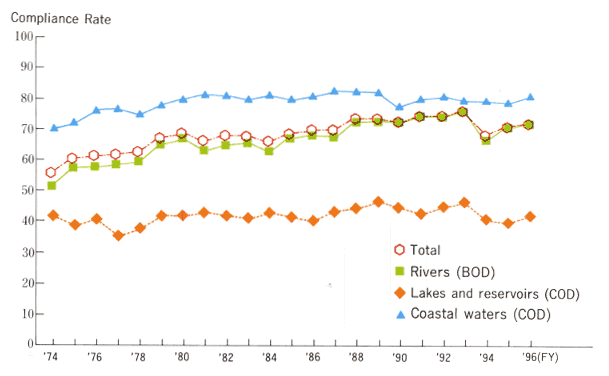
Non-Compliance Rate of EQS (Human Health Matters)
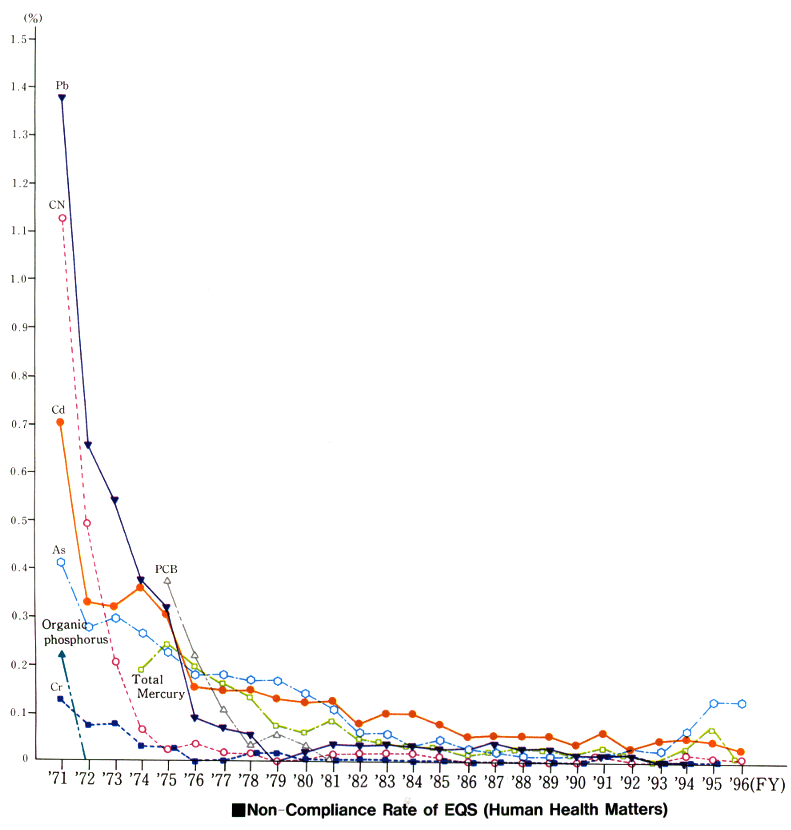 Zoom in
Zoom in
(3) Causes
The reinforced effluent regulations for factories have been effective in improving water quality, but problems with domestic wastewater remain and efforts to improve this situation have lagged because of insufficient sewerage treatment system infrastructure.
In addition to the physical characteristics of enclosed or semi-enclosed water bodies, such as low water turnover rates, another important factor contributing to water quality problems is the concentration of people and industries in these catchment areas. The inability of the infrastructure to keep up with expanding population and residential and industrial development has resulted in polluted water.
Conservation of water quality requires good salvage disposal systems and compliance with current effluent regulations. Domestic effluent treatment, which includes installation and maintenance of on-site treatment tanks, is key to improvement of the water quality of public waters, in particular those areas where no public sewerage system is currently available or where there are no plans for such a system.
Since enclosed waters have only limited absorptive capacities, efforts are also being made to reduce the nutrient loading from animal husbandry and fisheries. Consideration and implementation of appropriate countermeasures against non-point source pollution and accumulated pollution are also necessary. Non-point source pollution, which originates from broad areas such as urban developments and agricultural fields, combines with rainfall and pollutes receiving waters. Accumulated pollution can result from the release of pollutants from bottom sediments that were brought from land.
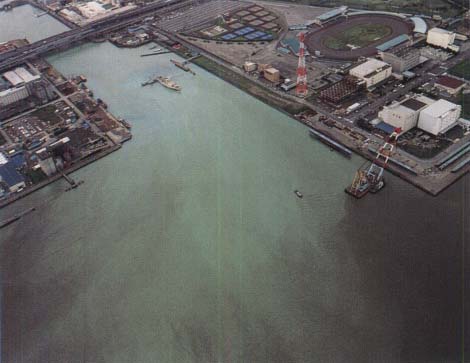
"Blue" Tide
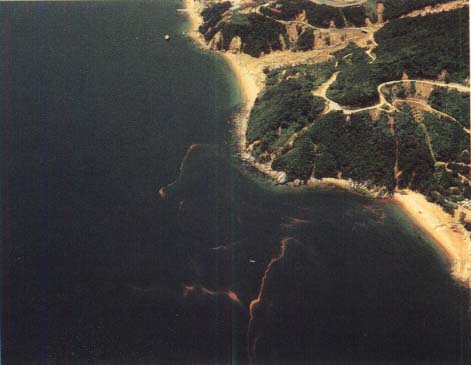
Red Tide
State of Water Pollution in Major Rivers(FY'96)
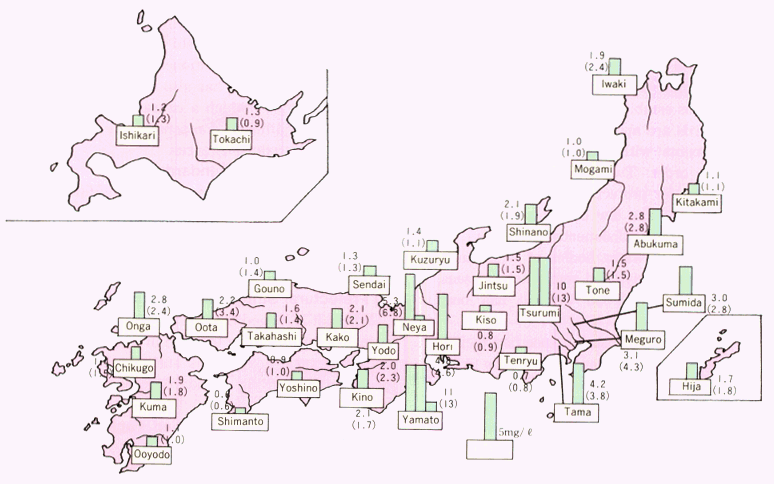 Zoom in
Zoom in